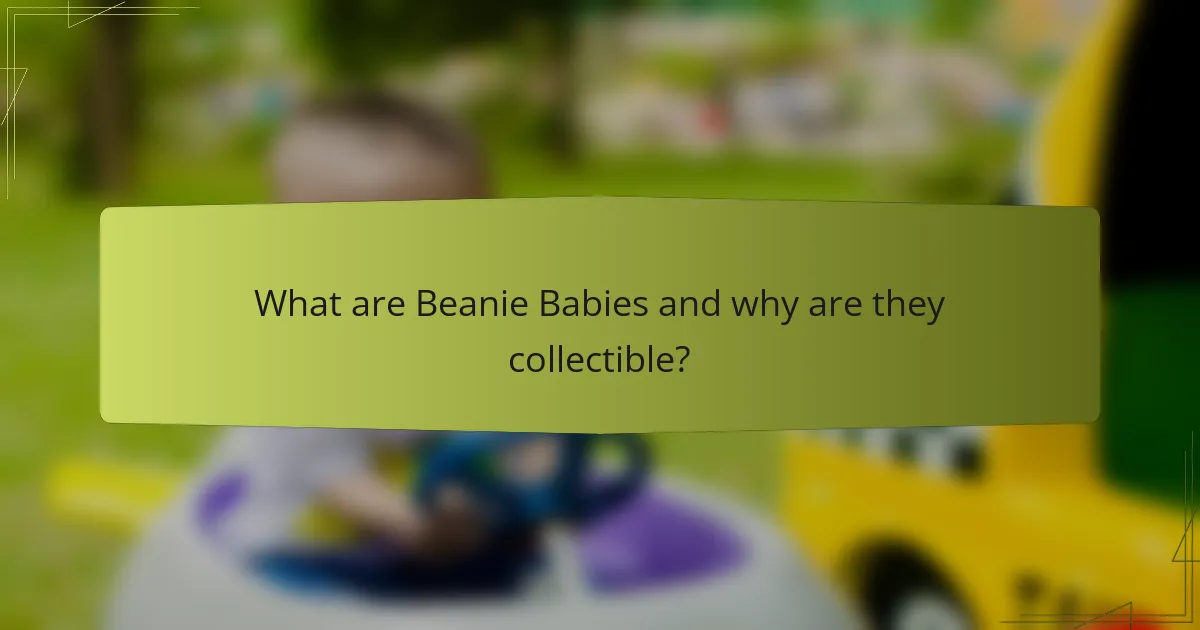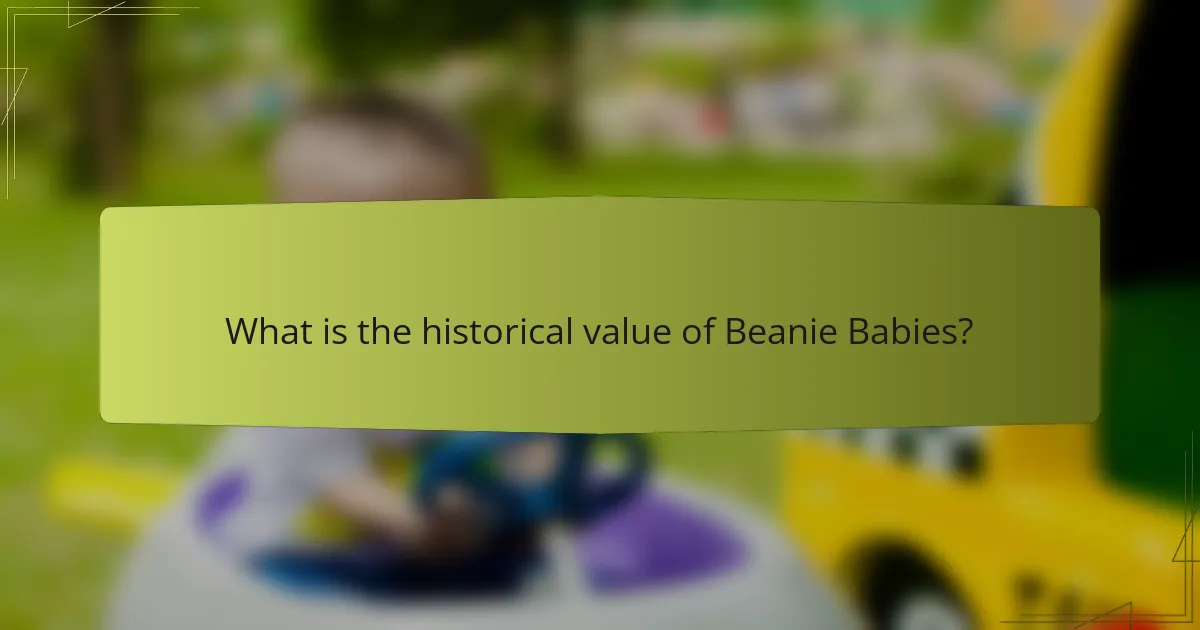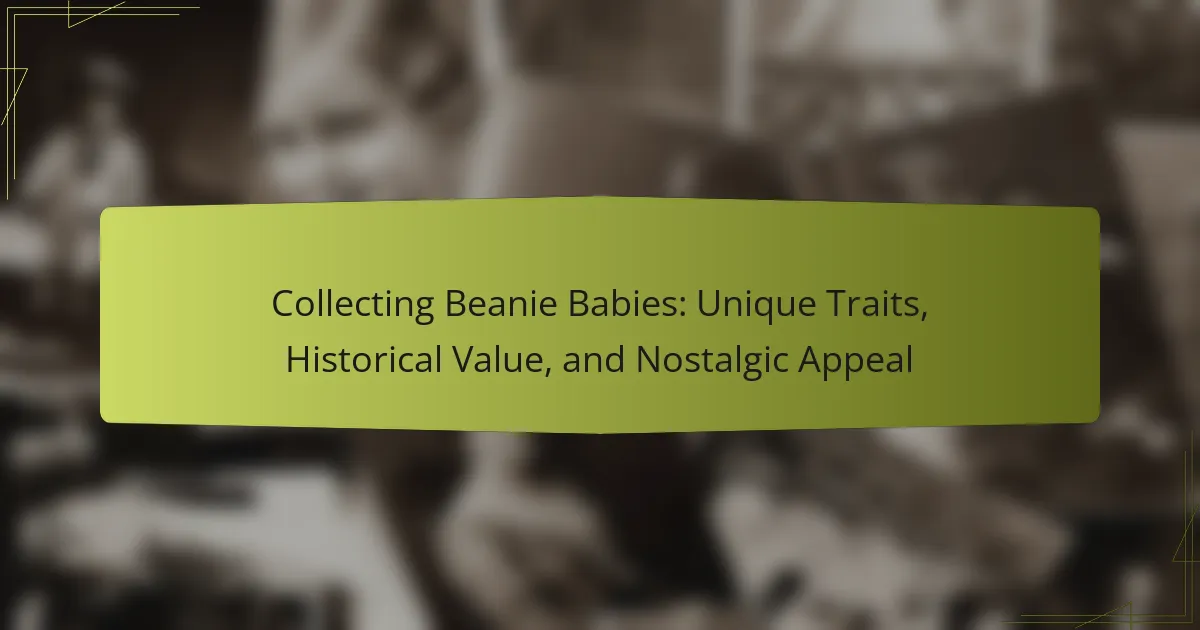Beanie Babies are collectible stuffed animals created by Ty Inc. in the 1990s, characterized by their unique designs, names, and limited production runs. The nostalgia surrounding Beanie Babies, along with their rarity, has contributed to their appeal among collectors, some of whom seek these items for sentimental reasons or as investments. The market for Beanie Babies peaked in the late 1990s, with rare editions selling for thousands of dollars, such as the Princess Diana bear, which auctioned for over $10,000. Despite a decline in market value in the early 2000s, certain rare Beanie Babies still retain worth today. Collecting these toys requires understanding market trends, rarity, and the importance of condition, as well as networking with other collectors and utilizing online platforms for transactions.

What are Beanie Babies and why are they collectible?
Beanie Babies are stuffed animals filled with plastic pellets, created by Ty Inc. in the 1990s. They feature unique designs and names, making each one distinct. The combination of rarity and limited production runs contributes to their collectibility. Many Beanie Babies were retired, increasing their value among collectors. Some rare editions can sell for thousands of dollars. The nostalgia associated with Beanie Babies also drives demand. Collectors often seek them for sentimental reasons or as investments. The phenomenon peaked in the late 1990s, leading to a significant market for these toys.
How did Beanie Babies become a cultural phenomenon?
Beanie Babies became a cultural phenomenon due to their unique design and marketing strategies. Launched by Ty Inc. in 1993, they featured distinct styles and names. Limited production runs created scarcity and heightened demand. Collectors viewed them as investment opportunities. The internet played a crucial role in their popularity. Online forums and auction sites facilitated buying and selling. Media coverage amplified their cultural significance. By the late 1990s, they were a staple in pop culture, symbolizing a collecting craze.
What factors contributed to the initial popularity of Beanie Babies?
The initial popularity of Beanie Babies was driven by their unique designs and limited availability. Each Beanie Baby featured distinct characteristics, making them collectible. The company, Ty Inc., often released limited editions, creating a sense of urgency among buyers. This strategy encouraged consumers to purchase quickly, fearing they might miss out. Additionally, the rise of the internet facilitated a secondary market for trading and selling Beanie Babies. Collectors could connect and share information online, increasing demand. Media coverage and celebrity endorsements further boosted their visibility. These factors combined to create a cultural phenomenon in the 1990s.
How did marketing strategies influence Beanie Babies’ collectibility?
Marketing strategies significantly influenced Beanie Babies’ collectibility by creating scarcity and demand. Ty Inc. employed limited production runs, making certain Beanie Babies rare. This tactic heightened consumer interest and drove up prices. Promotions, such as introducing new designs and retiring others, further fueled collectibility. Ty Inc. also utilized media appearances and celebrity endorsements to enhance visibility. The company cultivated a community of collectors through events and online forums. This engagement fostered a sense of loyalty and urgency among buyers. Overall, these strategies effectively transformed Beanie Babies into a cultural phenomenon, leading to their status as collectibles.
What unique traits do Beanie Babies possess?
Beanie Babies possess unique traits such as limited production runs and specific character designs. Each Beanie Baby has a distinct name and birthdate, adding to its individuality. The use of plastic pellets inside gives them a unique feel and allows them to sit upright. Many Beanie Babies feature unique tags with specific information, including the poem and the Ty logo. Some editions are retired, increasing their rarity and value among collectors. The combination of these factors makes Beanie Babies highly sought after in the collectibles market.
What are the defining characteristics of Beanie Babies?
Beanie Babies are collectible stuffed animals filled with plastic pellets. They were created by Ty Inc. in the 1990s. Each Beanie Baby has a unique name and a specific design. They often represent various animals, including mythical creatures. The tags contain information about the character and its birth date. Limited production runs increase their rarity and value. Many collectors seek rare editions for investment purposes. The emotional connection and nostalgia enhance their appeal among collectors.
How do rare and unique attributes affect their value?
Rare and unique attributes significantly increase the value of Beanie Babies. Collectors highly prize rare attributes, such as limited production runs or distinctive features. Unique attributes, like specific tag errors, can create a sense of exclusivity. This exclusivity often drives demand and, consequently, price. For example, a Beanie Baby with a rare color variant can fetch thousands of dollars. Similarly, unique misprints can lead to inflated valuations in the collector’s market. Historical context also plays a role; items linked to significant events or trends often gain additional value. Thus, the interplay of rarity and uniqueness directly correlates with increased monetary worth in the Beanie Baby collecting community.

What is the historical value of Beanie Babies?
The historical value of Beanie Babies peaked in the late 1990s. During this time, they became a cultural phenomenon and a collectible item. Prices for rare Beanie Babies reached thousands of dollars. For example, the Princess Diana bear sold for over $10,000 at auction. The initial retail price was typically around $5. Collectors believed that some Beanie Babies would appreciate in value over time. This led to speculation and hoarding behaviors among fans. However, the market for Beanie Babies declined significantly in the early 2000s. Many collectors found that their investments did not yield the expected returns. Today, some rare Beanie Babies still hold value, but most are worth far less than their peak prices.
How has the market for Beanie Babies evolved over time?
The market for Beanie Babies has significantly evolved since their introduction in the 1990s. Initially, Beanie Babies were sold at retail prices, often around $5. Their popularity surged in the mid-1990s, leading to inflated resale values. Some rare Beanie Babies sold for thousands of dollars during this peak.
However, by the early 2000s, the market experienced a decline. Many collectors found that the values of their collections dropped considerably. The oversaturation of the market contributed to this decline. By 2005, many Beanie Babies could be purchased for less than their original retail price.
In recent years, the market has seen a resurgence in interest. Nostalgia has driven some collectors to revisit their childhood collections. Online marketplaces have facilitated renewed buying and selling activity. Certain rare Beanie Babies still command high prices, reflecting their enduring appeal among collectors.
What were the peak years for Beanie Baby sales?
The peak years for Beanie Baby sales were 1995 to 1999. During this period, sales reached their highest levels. The popularity of Beanie Babies surged due to various factors. Collectors sought limited editions and rare items. Ty Inc. introduced new designs frequently, creating demand. In 1996, Beanie Babies became a cultural phenomenon. Reports indicated that sales exceeded $1 billion in 1998. The market began to decline after 1999, leading to decreased sales.
How do historical events impact the value of Beanie Babies today?
Historical events significantly impact the value of Beanie Babies today. The 1990s Beanie Baby craze created a massive demand and inflated prices. Events like the company’s decision to retire certain models increased scarcity, driving up their value. The introduction of limited editions and unique characters also contributed to their desirability. Economic factors, such as recessions, can lead to decreased interest and value. Additionally, nostalgia for the 1990s has revived interest among collectors. Current market trends show that rare Beanie Babies can fetch high prices at auctions. Factors like condition and original tags further influence their worth.
What role does nostalgia play in Beanie Baby collecting?
Nostalgia plays a significant role in Beanie Baby collecting. Many collectors are driven by fond memories from the 1990s, when these toys became a cultural phenomenon. The emotional connection to childhood experiences enhances the appeal of collecting. Nostalgic feelings can lead to a desire to recapture simpler times. This emotional aspect often motivates collectors to seek out specific Beanie Babies. Furthermore, nostalgia can influence the perceived value of rare or limited-edition items. The combination of emotional attachment and rarity makes Beanie Babies highly sought after. Collectors often share stories that reinforce the nostalgic community around these toys.
Why do collectors feel a nostalgic connection to Beanie Babies?
Collectors feel a nostalgic connection to Beanie Babies due to their association with childhood memories. These plush toys were immensely popular in the 1990s, often gifted during birthdays and holidays. The emotional attachment stems from the joy and excitement they brought to children during that era. Many collectors recall the thrill of searching for rare editions in stores. The limited availability of certain Beanie Babies added to their allure and significance. Additionally, the community surrounding Beanie Baby collecting fostered friendships and shared experiences. This social aspect further deepened the nostalgic feelings associated with these toys. The combination of personal memories and cultural significance creates a lasting emotional bond for collectors.
How does nostalgia influence the current market for Beanie Babies?
Nostalgia significantly influences the current market for Beanie Babies. Many collectors are driven by memories of their childhood and the emotional connection to these toys. This emotional pull creates a demand for Beanie Babies among adults who grew up in the 1990s. As a result, prices for certain rare Beanie Babies have surged in online marketplaces. For example, some rare editions have sold for thousands of dollars, reflecting their nostalgic value. The market is also supported by social media, where collectors share their collections and stories. This community aspect reinforces the nostalgic appeal, encouraging more purchases. The combination of emotional attachment and community engagement keeps the market vibrant.

What are the practical aspects of collecting Beanie Babies?
Collecting Beanie Babies involves understanding market trends and rarity. Collectors should research which Beanie Babies are considered rare or valuable. The condition of the toys significantly affects their value. Original tags and packaging enhance collectible worth. Networking with other collectors can provide insights and trading opportunities. Online marketplaces often offer a platform for buying and selling. Tracking prices through collector guides ensures informed purchasing decisions. Storage in a climate-controlled environment prevents damage and preserves value.
How can collectors assess the value of their Beanie Babies?
Collectors can assess the value of their Beanie Babies by researching current market trends. They can check online auction sites like eBay for recent sale prices. Additionally, collectors should reference price guides that specialize in Beanie Babies. These guides provide estimated values based on rarity and demand. Condition also plays a crucial role in valuation. Mint condition Beanie Babies with tags will typically fetch higher prices. Collectors should also consider the specific attributes of each Beanie Baby, such as unique designs or limited editions. Historical significance can further influence value, as certain Beanie Babies were produced during specific events or eras.
What criteria should be used to determine the condition of Beanie Babies?
The condition of Beanie Babies can be determined using several criteria. These include the presence of tags, overall appearance, and any signs of wear. Tags should be intact and not faded. The overall appearance should be clean and free from stains or damage. Additionally, checking for original packaging can add to the value. The rarity of the specific Beanie Baby also influences its condition assessment. Collectors often refer to price guides for specific condition ratings. The criteria are widely accepted among collectors and affect market value significantly.
How do collectors identify rare Beanie Babies?
Collectors identify rare Beanie Babies by examining specific attributes such as tags, errors, and limited editions. The condition of the Beanie Baby is crucial; mint condition items are more valuable. Tags can include first edition or rare variations, which increase rarity. Some Beanie Babies have unique features, like misspelled names or unusual fabric. Limited production runs also contribute to rarity. Collectors often reference price guides and online databases for valuation. The demand for specific characters enhances their rarity. Provenance and historical significance can further elevate a Beanie Baby’s value.
What tips can help new collectors get started with Beanie Babies?
Research Beanie Baby history and rarity. Understanding the origins helps identify valuable pieces. Start with popular characters like Ty Beanie Babies. These are often sought after and easier to find. Join online forums and local collector groups. Networking can provide insights and opportunities. Keep the original tags intact. Tags significantly affect the value of each Beanie Baby. Store Beanie Babies properly to avoid damage. Use display cases or protective bags. Regularly check the market for trends. Prices can fluctuate based on demand.
What resources are available for Beanie Baby collectors?
Beanie Baby collectors have access to several valuable resources. Online marketplaces like eBay and Etsy provide platforms for buying and selling Beanie Babies. Collector forums, such as Beaniepedia, offer community support and information. Price guides, like the “Ty Beanie Babies Collector’s Guide,” help assess value. Social media groups enable networking and sharing of tips. Local toy shows and conventions allow collectors to connect in person. Websites dedicated to Beanie Babies provide news and updates on new releases. These resources enhance the collecting experience and help maintain accurate knowledge of the market.
How can collectors build and maintain a valuable Beanie Baby collection?
Collectors can build and maintain a valuable Beanie Baby collection by focusing on rarity, condition, and market trends. Rarity is crucial; limited edition and retired Beanie Babies often appreciate in value. Condition significantly impacts value; items should be kept in pristine condition, ideally with original tags. Researching market trends helps collectors understand which Beanie Babies are in demand. Joining collector communities can provide insights and networking opportunities. Keeping a detailed inventory aids in tracking valuable items. Regularly assessing the collection’s value can inform selling decisions. Collectors should also be cautious of counterfeit products, as authenticity is vital for maintaining value.
Collecting Beanie Babies revolves around unique traits, historical value, and nostalgic appeal. Beanie Babies, created by Ty Inc. in the 1990s, are stuffed animals characterized by their distinct designs, limited production runs, and emotional connections for collectors. The article explores how marketing strategies, rarity, and nostalgia contributed to their cultural phenomenon status, influencing both their collectibility and market value. Additionally, it provides insights into assessing value, identifying rare editions, and tips for new collectors to build and maintain a valuable collection.
